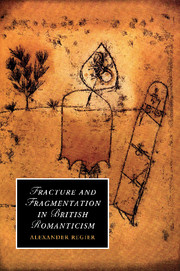Book contents
- Frontmatter
- Contents
- Acknowledgements
- List of abbreviations
- Broken origins: an introduction
- 1 A brotherhood is broken: Babel and the fragmentation of language
- 2 Figuring it out: the origin of language and anthropomorphism
- 3 Forces trembling underneath: the Lisbon earthquake and the sublime
- 4 A blue chasm: Wordsworth's The Prelude and the figure of parenthesis
- 5 Letters from the grave: John Keats's fragmented corpus
- 6 The doubling force of citation: De Quincey's Wordsworthian archive
- 7 Philological fractures: Paul de Man's Romantic rhetoric
- Notes
- Bibliography
- Index
- CAMBRIDGE STUDIES IN ROMANTICISM
5 - Letters from the grave: John Keats's fragmented corpus
Published online by Cambridge University Press: 06 July 2010
- Frontmatter
- Contents
- Acknowledgements
- List of abbreviations
- Broken origins: an introduction
- 1 A brotherhood is broken: Babel and the fragmentation of language
- 2 Figuring it out: the origin of language and anthropomorphism
- 3 Forces trembling underneath: the Lisbon earthquake and the sublime
- 4 A blue chasm: Wordsworth's The Prelude and the figure of parenthesis
- 5 Letters from the grave: John Keats's fragmented corpus
- 6 The doubling force of citation: De Quincey's Wordsworthian archive
- 7 Philological fractures: Paul de Man's Romantic rhetoric
- Notes
- Bibliography
- Index
- CAMBRIDGE STUDIES IN ROMANTICISM
Summary
A dialogue is a chain or a garland of fragments. An exchange of letters is a dialogue on an enlarged scale, and memorabilia are a system of fragments.
LETTERS AS LITERATURE
This chapter is on John Keats and fragmentation. Its main body and argument will show that the rhetoric of Keats's letters reveals how his epistolary poetics relies on an economy of fracture and reciprocal movement. I will attempt to explain how this dynamic of exchange parallels the condition of a linguistic predicament of brokenness. Finally, the analysis will illustrate how the letter in Keats's work becomes a fragmentary principle around which his posthumous corpus is constructed. Keats's grave, containing an unopened letter addressed to him, and marked by a broken lyre, offers a powerful image for the way his corpus relies on fragmentariness. Fragmentation becomes the point around which his archival body, dominated by the rhetoric of brokenness, is assembled and understood. The discussion thus locates a fracture at the point of supposed origin. As its title indicates, the chapter will focus mostly on Keats's letters and their reception. While this is not a canonical straitjacket, I have mostly omitted references to, and discussions of, his poetry. This is a directed and critically deliberate decision. As will transpire, I believe that the formal status of the letter is especially powerful in illustrating the link between fragmentation and Romanticism.
- Type
- Chapter
- Information
- Fracture and Fragmentation in British Romanticism , pp. 119 - 140Publisher: Cambridge University PressPrint publication year: 2010

